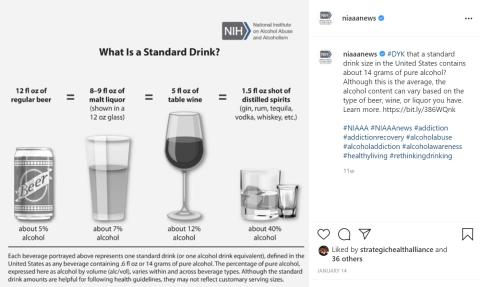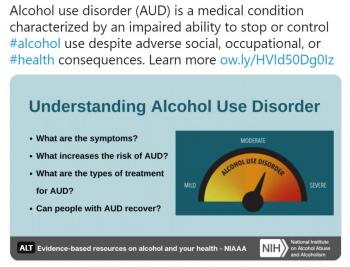NIAAA Director's Report on Institute Activities to the 157th Meeting of the National Advisory Council on Alcohol Abuse and Alcoholism
Virtual Meeting
Table of Contents
- IN MEMORIAM
- NIAAA BUDGET
- HONORS AND AWARDS
- STAFF TRANSITIONS
- RECENTLY ISSUED FUNDING OPPORTUNITYANNOUNCEMENTS
- NIAAA DIRECTOR'S ACTIVITIES
- NOTABLE NIAAA STAFF ACTIVITIES
- WHAT'S AHEAD?
- NIAAA RESEARCH HIGHLIGHTS
- NIAAA COMMUNICATIONS AND PUBLIC LIAISON ACTIVITIES
IN MEMORIAM

Mary Jeanne Kreek, M.D., passed away in March 2021. Dr. Kreek contributed enormously to the study of addiction, and her work has been crucial in eroding the stigma that still surrounds addiction and its treatment. Her seminal contributions include her work with Drs. Vincent Dole and Marie Nyswander helping to develop the first medication for opioid use disorder, methadone, and contributing to the development of another medication for opioid use disorder, buprenorphine. She also identified injection drug use as the second major risk behavior for HIV transmission, and she contributed significantly to our basic research understanding of the neurobiology of addiction. Dr. Kreek received many awards and honors during her illustrious career, including the Association for Multidisciplinary Education and Research in Substance Use and Addiction Betty Ford Award, the National Institute on Drug Abuse Lifetime Science Award, the American Academy of Addiction Psychiatry’s Founders’ Award, and the Nathan B. Eddy Memorial Award for Lifetime Excellence in Drug Abuse Research from the College on Problems of Drug Dependence.

Emanuel (Manny) Rubin, M.D., passed away in February 2021. Dr. Rubin was an internationally recognized academic pathologist with an all-encompassing knowledge of molecular pathology and investigator of the alcohol-induced pathogenesis of heart and liver disease. Dr. Rubin’s seminal contributions to the study of alcohol’s effects on the body include providing definitive evidence that alcohol toxicity, rather than poor nutrition, was responsible for organ damage related to alcohol misuse (a collaboration with Dr. Charles Lieber) and identifying mitochondrial dysfunction in the heart and liver as the target of alcohol toxicity. Dr. Rubin established an Alcohol Research Center, first at Hahnemann University, then at Thomas Jefferson University, Philadelphia, Pennsylvania. Dr. Rubin’s achievements have been recognized through numerous honors, including the 2015 Lifetime Achievement Award from the Research Society on Alcoholism and the Gold-Headed Cane Award from the American Society of Investigative Pathology.
NAAA BUDGET
Fiscal Year (FY) 2021
On December 27, 2020, the President signed the H.R. 133 - Consolidated Appropriations Act, 2021. The National Institutes of Health (NIH) received a total of $42.9 billion, $1.25 billion above the FY 20 enacted level. NIH also received supplemental funding of $1.25 billion through FY 2024 from the coronavirus supplemental appropriations included in H.R. 133. Additionally, funding includes allocations for the Helping to End Addiction Long-term (HEAL) Initiative, the 21st Century Cures Act, Brain Research through Advancing Innovative Neurotechnologies (BRAIN) Initiative, and research on influenza. The bill provides a general increase to NIH Institutes and Centers, and it continues to support the Gabriella Miller Kids First Act pediatric research initiative.
The FY 21 appropriation for NIAAA provides $554.9 million, which represents an $8.2 million (1.8 percent) increase over the FY 20 actual budget level. At this time, NIAAA estimates it will support a total of 699 research project grants in FY 2021.
FY 2022
The preparation of the FY 22 President’s Budget is underway as of April 2021.
HONORS AND AWARDS
Dr. Shana Augustin, Research Fellow in the Laboratory for Integrative Neuroscience, received a Henry Grass, M.D., Rising Stars in Neuroscience Achievement Award from The Grass Foundation.
STAFF TRANSITIONS
New Staff

Shera Smith joined NIAAA as an Extramural Support Assistant in the Review Branch, Office of Extramural Activities. Mrs. Smith is a military spouse and has worked for the U.S. Army since 2007. Prior to joining NIAAA, she was the lead technician at Moncrief Army Health Clinic, Department of the Army, Columbia, South Carolina, and worked as a Human Resource Specialist. She has a bachelor’s degree in health care administration/management and master’s degree in health resource management.

Khushbu Agarwal, Ph.D., Postdoctoral Visiting Fellow, joined the Section of Sensory Science and Metabolism, Division of Intramural Clinical and Biological Research (DIBCR). She was previously a Postdoctoral Visiting Fellow at the National Institute of Nursing Research. Dr. Agarwal earned her doctorate in 2017 from the Institute of Medical Sciences, New Delhi, India, in the field of nuclear magnetic resonance imaging and spectroscopy. Dr. Agarwal will apply her expertise and skills in neuroimaging techniques and data analysis to the study of the relationship between hedonic pathways, sensory systems, and disease. She is interested in the interplay between metabolic disorders, sensory-related pathways, and brain diseases—particularly alcohol and substance use disorders.

Abhishek Basu, Ph.D., joined the Section on Fibrotic Disorders, DIBCR, as a Postdoctoral Visiting Fellow. Dr. Basu received his doctorate in pharmacy from Jadavpur University, Kolkata, India, in 2017. Dr. Basu’s work in the Section of Fibrotic Disorders will focus on scientific projects exploring the molecular mechanisms involved in the development of pulmonary fibrosis of various etiology, including alcohol-induced lung injury, and testing novel therapeutic agents designed in-house using animal models of fibrotic disorders.

Yukun Guan, Ph.D., joined the Laboratory of Liver Diseases, DIBCR, as a Postdoctoral Visiting Fellow. Dr. Guan earned his bachelor’s in biology from Lanzhou University, and doctorate in cell biology from Beijing University in China. He joined NIH as a Postdoctoral Visiting Fellow at the National Cancer Institute in 2017. In the Laboratory of Liver Diseases, Dr. Guan will study the roles of innate immune cells and cytokines in liver injury, regeneration, and cancer. Particularly, he will study the molecular mechanisms by which interleukin-22 receptor expression in hepatocytes and other epithelial cells are regulated, and the roles of various subsets of macrophages in controlling liver metabolism, injury, and regeneration.

Markos Woldeyohannes, M.D., Ph.D., Postdoctoral Visiting Fellow, joined the Section of Sensory Science and Metabolism, DIBCR. Dr. Woldeyohannes came to NIH as a fellow under the African Postdoctoral Training Initiative, previously working at the National Institute of Nursing Research. At NIAAA, Dr. Woldeyohannes’ research will focus on the intersection of nutrition and psychiatry. Dr. Woldeyohannes received his medical degree in 2002 from the Faculty of Medical Sciences, Jimma University, Ethiopia, and his doctorate in 2016, from the Faculty of Science, University of Copenhagen, Denmark.
Internal Transitions

Resat Cinar, Ph.D., transitioned to Tenure Track Investigator and Acting Chief for the Section on Fibrotic Disorders, DICBR. The mission of the section is to understand the cellular and molecular mechanisms involved in the development and progression of fibrosis, to explore novel therapeutic targets, and to develop effective pharmacotherapies for fibrotic disorders of different etiologies, including alcohol use disorder. Since joining NIAAA in 2009, Dr. Cinar has held appointments as Postdoctoral Visiting Fellow, Research Fellow, and Staff Scientist in DICBR.

Malliga Iyer, Ph.D., transitioned to Tenure Track Investigator and Acting Chief for the Section on Medicinal Chemistry, DICBR. The mission of the section is to develop selective probes and drug-like molecules to enable the study of molecular mechanisms in alcohol-associated diseases. Dr. Iyer established a medicinal chemistry core in her previous role as Research Fellow in the NIAAA Office of the Scientific Director, a position in which she was the driving force in the creative design of a new class of peripherally restricted, dual-target CB1 receptor antagonists/inverse agonists as potential therapy for various forms of tissue fibrosis, including liver fibrosis related to alcohol misuse.

Janos Paloczi, Ph.D., transitioned from Postdoctoral Visiting Fellow to Research Fellow in the Laboratory on Cardiovascular Physiology Tissue Injury, DIBCR. Dr. Paloczi currently is a key investigator in several ongoing research projects investigating the synergistic detrimental cardiovascular consequences of binge drinking and synthetic cannabinoid consumption. As a Research Fellow, Dr. Paloczi will also explore the role of gut microbiome in acute alcohol-induced hemodynamic effects, the role of acetaldehyde in the hemodynamic effects of alcohol, and the contribution of central and peripheral CB1R signaling in alcohol use disorder-induced acute cardiovascular effects. Prior to joining NIAAA as a Postdoctoral Visiting Fellow, Dr. Paloczi earned his doctorate in theoretical medical sciences in 2015 at the University of Szeged, Szeged, Hungary.
Departing Staff
Emily Buzgierski, Administrative Officer, departed the Administrative Services Branch, Office of Resource Management, for a new position with the Division of Management Services, Center for Scientific Review, where she will serve as an Administrative Officer.
Carlos Gomez, Administrative Officer, departed NIAAA to begin a new opportunity serving as an Administrative Officer for the NIH Office of Extramural Research, Strategic Management and Contracts Office, where he will be responsible for providing administrative duties supporting staff.
RECENTLY ISSUED NOTICE OF FUNDING OPPORTUNITIES
Notice of Funding Opportunities (NOFOs) Issued by NIAAA:
SARS-CoV-2, COVID-19 and Consequences of Alcohol Use (R01 – Clinical Trial Not Allowed; R03 – Clinical Trial Not Allowed; R21 – Clinical Trial Not Allowed): This NOFO will support research grants to address urgent, time-sensitive research questions on the relationships between alcohol misuse and COVID-19 related outcomes and consequences. The principal area of focus is research that can improve public health in the near term by informing responses to the current COVID-19 pandemic, in view of 1) the impact of alcohol misuse on incidence and severity of COVID-19 disease or 2) the effect of the COVID-19 disease and pandemic-induced restrictions on alcohol use and alcohol use disorder (AUD). RFA-AA-21-002; RFA-AA-21-003; RFA-AA-21-004
Specialized Alcohol Research Centers (P50 – Clinical Trial Optional): The overall purpose of the NIAAA Alcohol Research Center program (without the dissemination component) is to provide leadership in conducting and fostering interdisciplinary, collaborative research on a wide variety of topics relevant to the Institute’s mission. RFA-AA-21-005
Comprehensive Alcohol Research Centers (P60 – Clinical Trial Optional): This NOFO invites applications for Comprehensive Alcohol Research Centers using the P60 mechanism which requires a dissemination core to initiate and expand community education related to the activities of the center. The overall purpose of the NIAAA Alcohol Research Center program is to provide leadership in conducting and fostering interdisciplinary, collaborative research on a wide variety of topics relevant to the Institute’s mission. RFA-AA-21-006
NIH-Wide NOFOs with NIAAA Participation:
BRAIN Initiative: Development and Validation of Novel Tools to Probe Cell-Specific and Circuit-Specific Processes in the Brain (R01 – Clinical Trial Not Allowed) RFA-MH-21-175
BRAIN Initiative: Reagent Resources for Brain Cell Type-Specific Access and Manipulation to Broaden Distribution of Enabling Technologies for Neuroscience (U24 – Clinical Trial Not Allowed) RFA-MH-21-180
BRAIN Initiative: Targeted BRAIN Circuits Planning Projects TargetedBCPP (R34 – Clinical Trials Not Allowed) RFA-NS-21-014
BRAIN Initiative: Targeted BRAIN Circuits Projects – TargetedBCP (R01 – Clinical Trial Not Allowed) RFA-NS-21-013
BRAIN Initiative: Integration and Analysis of BRAIN Initiative Data (R01 – Clinical Trial Not Allowed) RFA-MH-21-135
BRAIN Initiative: Secondary Analysis and Archiving of BRAIN Initiative Data (R01 – Clinical Trial Not Allowed) RFA-MH-21-130
Blueprint Neurotherapeutics Network (BPN): Biologic-based Drug Discovery and Development for Disorders of the Nervous System (U44 – Clinical Trial Optional) PAR-21-233
Blueprint Neurotherapeutics Network (BPN): Biologic-based Drug Discovery and Development for Disorders of the Nervous System (UG3/UH3 – Clinical Trial Optional) PAR-21-163
NIH Blueprint and BRAIN Initiative Diversity Specialized Predoctoral to Postdoctoral Advancement in Neuroscience (D-SPAN) Award (F99/K00 – Clinical Trial Not Allowed) RFA-NS-21-012
HEAL Initiative: Analgesic Development Initial Translational Efforts [Small Molecules and Biologics] (U19 – Clinical Trial Not Allowed) RFA-NS-21-015
HEAL Initiative: Planning Studies for Initial Analgesic Development Initial Translational Efforts [Small Molecules and Biologics] (R34 – Clinical Trial Not Allowed) RFA-NS-21-016
Pilot and Feasibility Studies in Preparation for Substance Use Prevention Trials (R34 – Clinical Trial Optional) PA-21-110
Building Interdisciplinary Research Careers in Women's Health Program (BIRCWH) (K12 – Clinical Trial Optional) RFA-OD-21-006
Emergency Award: RADx-UP - Social, Ethical, and Behavioral Implications (SEBI) Research on Disparities in COVID-19 Testing among Underserved and Vulnerable Populations (U01 – Clinical Trials Optional) RFA-OD-21-009
Emergency Awards: Community-engaged COVID-19 Testing Interventions among Underserved and Vulnerable Populations RADx-UP Phase II (U01 – Clinical Trial Optional) RFA-OD-21-008
Emergency Award: Social, Behavioral, and Economic Research on COVID-19 Consortium (U01 – Clinical Trial Not Allowed) PAR-21-213
Understanding and Addressing the Impact of Structural Racism and Discrimination on Minority Health and Health Disparities (R01 Clinical Trial Optional) RFA-MD-21-004
Support for Research Excellence (SuRE) Award (R16 – Clinical Trial Not Allowed) PAR-21-169
Support for Research Excellence First Independent Research (SuRE-First) Award (R16 – Clinical Trial Not Allowed) PAR-21-173
Short Courses on Innovative Methodologies and Approaches in the Behavioral and Social Sciences (R25 – Independent Clinical Trial Not Allowed) RFA-OD-21-005
Maximizing the Scientific Value of Existing Biospecimen Collections (R21 – Clinical Trial Not Allowed) RFA-OD-21-004
Secondary Analyses of Existing Datasets of Tobacco Use and Health (R21 – Clinical Trial Not Allowed) RFA-OD-21-003
Firearm Injury and Mortality Prevention Research (R01 – Clinical Trial Optional; R21/R33 – Clinical Trial Optional) PAR-21-191; PAR-21-192
Tobacco Regulatory Science (R01 – Clinical Trial Optional) RFA-OD-21-002
Research on Biopsychosocial Factors of Social Connectedness and Isolation on Health, Wellbeing, Illness, and Recovery (R01 – Basic Experimental Studies with Humans Required; R01 – Clinical Trials Not Allowed) PAR-21-144; PAR-21-145
NIH-Wide NOSIs with NIAAA Participation:
BRAIN Initiative: Translation of BRAIN Initiative Technologies to the Marketplace NOT-MH-21-125
BRAIN Initiative: Availability of Administrative Supplements for BRAIN Initiative Awardees to Support Resource Dissemination NOT-NS-21-014
HEAL Initiative: Limited Competition to Support Mentorship of Junior Investigators NOT-NS-21-026
HEAL Initiative: Availability of Administrative Supplements to Support Strategies to Increase Participant Diversity, Inclusion and Engagement in Clinical Studies NOT-NS-21-025
HEAL Initiative: Encourage Eligible NIH HEAL Initiative Awardees to Apply for Administrative Supplements to Support Career Enhancement Related to Clinical Research on Pain (Admin Supp Clinical Trial Not Allowed) NOT-NS-21-048
Women and Sex/Gender Differences in Drug and Alcohol Abuse/Dependence NOT-DA-21-012
Administrative Supplements for Rapid Acceleration of Diagnostics-Underserved Populations (RADx-UP) Phase I Projects to Address Vaccine Hesitancy and Uptake NOT-OD-21-101
Emergency Competitive Revisions for Community-engaged COVID-19 Testing Interventions among Underserved and Vulnerable Populations RADx-UP Phase II (Emergency Supplement - Clinical Trial Optional) NOT-OD-21-103
Administrative Supplements for Workforce Development at the Interface of Information Sciences, Artificial Intelligence and Machine Learning (AI/ML), and Biomedical Sciences NOT-OD-21-079
Administrative Supplements to Support Enhancement of Software Tools for Open Science NOT-OD-21-091
Support for existing data repositories to align with FAIR and TRUST principles and evaluate usage, utility, and impact NOT-OD-21-089
Developing and Testing Multilevel Physical Activity Interventions to Improve Health and Well-Being NOT-OD-21-087; NOT-AA-21-013
Notice of Information: Reissuance of PAR-18-307 “Developing Interventions for Health-Enhancing Physical Activity (R21/R33 - Clinical Trial Optional)” as NOSI NOT-OD-21-087
Other Notices:
Notice of Information: NIAAA Clinical Medications Development Testing Program. The purpose of this notice is to raise awareness of the medications development contract clinical program for testing promising new medications to treat alcohol use disorder (AUD) in alcohol interaction and Phase II human laboratory and clinical trials. Potential medication candidates for the program arise from many sources including NIAAA-supported investigators, NIH initiatives, and pharmaceutical company research. NOT-AA-21-008
Notice of Intent to Publish a Notice of Funding Opportunity for Limited Competition for the Continuation of the National Consortium on Alcohol and Neurodevelopment in Adolescence (NCANDA) Research Project Sites NOT-AA-21-016; NOT-AA-21-017; NOT-AA-21-018.
Notice of Intent to Publish a Notice of Funding Opportunity for Collaborative Initiative on Fetal Alcohol Spectrum Disorders (CIFASD) NOT-AA-21-020; NOT-AA-21-021; NOT-AA-21-022; NOT-AA-21-023; NOT-AA-21-024
Special Notices for Early Career Investigators
Notice of Special Interest: Availability of Administrative Supplements for Childcare Costs for Ruth L. Kirschstein National Research Service Award (NRSA) Individual Fellows NOT-OD-21-070, NOT-OD-21-074, NOT-OD-21-075
Reminder – Requesting Extensions for Early Career Scientists Whose Career Trajectories Have Been Significantly Impacted by COVID-19 NOT-OD-21-052
Notice of Continuation of Temporary Extension of Eligibility for the NIH K99/R00 Pathway to Independence Award During the COVID-19 Pandemic NOT-OD-21-106
NAAA DIRECTOR'S ACTIVITIES
NIAAA Director George F. Koob, Ph.D., gave the following virtual presentations between January 1 and March 31, 2021:
- “Alcohol Use Disorder During the COVID-19 Pandemic” for the Johns Hopkins Delivery of Early Liver Transplant for Alcoholic Hepatitis (DELTA) Center for Alcohol Research Symposium, Alcoholic Hepatitis: Pathogenesis, Treatment, and Challenge, on January 15, 2021
- “NIAAA Update” for the Community Anti-Drug Coalitions of America National Leadership Forum on February 1, 2021
- “Opioid Addiction: Opponent Process, Hyperkatifeia, and Negative Reinforcement” for the University of California San Francisco Pain and Addiction Research Center International Pain and Addiction Conference on March 13, 2021
- “Addiction and Loss of Control: Hyperkatifeia, Negative Reinforcement, and the Dark Side of Addiction” for the Center for Academic Research and Training in Anthropogeny (CARTA) Symposium, Altered States of the Human Mind: Implications for Anthropogeny, on March 13, 2021
“NIAAA Update: The COVID-19 Pandemic and Beyond” for the Collaborative Perspectives on Addiction Conference (American Psychological Association Division 50, Society of Addiction Psychology) on March 18, 2021
NOTABLE NIAAA STAFF ACTIVITIES
Dr. Judith Arroyo participated in a webinar about NIH career development awards for the Research Society on Alcoholism Emerging Scholars Seminar Series on February 26, 2021.
Dr. Kendall Bryant presented an overview of NIH and NIAAA HIV and alcohol objectives and engaged in multiple mentoring activities at a Uganda Russia Boston Alcohol Network for Alcohol Research Collaboration on HIV/AIDS (URBAN ARCH; Boston University) trainee event held virtually on March 17, 2021, in lieu of a 2021 URBAN ARCH annual meeting. The URBAN ARCH event offered opportunities for trainees to network with senior investigators, including a meet-and-greet session followed by drop-in office hour sessions.
Dr. Mark Egli participated in a virtual expert panel for the University of Toronto School Neuroscience Brain Bee Club. The discussion between addiction experts and high school students focused on views regarding the neurobiology, psychology, clinical care aspects, and public health aspects of addiction. The discussion was held March 10, 2021.
Dr. Laura Kwako co-chaired a virtual session on NIH funding opportunities at the Addiction Health Services Research Conference on March 15, 2021. At the same conference, Dr. Mariela Shirley led a breakout session on early career and training funding opportunities.
Dr. Dominique Lorang-Leins, Dr. Jenica Patterson, and Greg Roa were involved in the development of a video for Virtual Brain Awareness Day held on March 19, 2021 and hosted by the National Museum of Health and Medicine as part of Brain Awareness Week.
Dr. John Matochik co-chaired the National Institute on Drug Abuse-NIAAA Frontiers in Addiction Research Mini-Convention, which was held as a virtual two-day event on January 7 and 8, 2021. He was also the chair for the Early Career Investigator Showcase at the event.
WHAT'S AHEAD?
The 16th Annual NIH Pain Consortium Symposium, Pain and Pandemics: Challenges and Opportunities in the Current Social and Healthcare Climate, will be held May 24 and 25, 2021, in an all-virtual format. Topics will include the impact of social determinants of health on chronic pain and pain management, the impact of COVID-19 on chronic pain and co-morbidities, and interventions for reducing health disparities. Members of the extramural scientific community, the NIH scientific community, health care providers, and the public are invited to attend. View the agenda and registration information at: https://www.painconsortium.nih.gov/
The 7th Annual Brain Research through Advancing Innovative Neurotechnologies (BRAIN) Initiative Investigators Meeting will be held virtually June 15-17, 2021. The meeting will convene BRAIN Initiative awardees, staff, and leadership from the contributing federal agencies (NIH, National Science Foundation, Defense Advanced Research Projects Agency, Intelligence Advanced Research Projects Agency, and U.S. Food and Drug Administration), plus representatives and investigators from participating non-federal organizations, and members of the media, public, and Congress. The purpose of this open BRAIN Initiative meeting is to provide a forum for sharing scientific developments and new directions and identifying areas for collaboration and research coordination. View meeting information at: https://www.brainmeeting2021.com/.
NIAAA RESEARCH HIGHLIGHTS
Brain Ethanol Metabolism by Astrocytic ALDH2 Drives the Behavioral Effects of Ethanol Intoxication
Significance: Hepatic aldehyde dehydrogenase 2 (ALDH2) is a key enzyme that converts acetaldehyde, a by-product of alcohol metabolism, to acetate, a compound shown to contribute to the behavioral effects of alcohol in animal models. ALDH2 is thought to be present in the brain, at much lower levels than the liver, and little is known about the potential involvement of brain ALDH2 in alcohol metabolism. In the current study, investigators identified the presence of ALDH2 in astrocytes of the cerebellum in humans and mice. They also demonstrated that astrocytic ALDH2-mediated the production of acetate. Astrocytic ALDH2 was found to mediate both alcohol- and acetate-induced cellular and behavioral effects, including impairment of balance and coordination skills, via GABAergic signaling. The findings pave the way for additional research on astrocytic ALDH2 as a potential target for the pathophysiology of alcohol use disorder.
Alcohol is among the most widely used psychoactive substances worldwide. Ethanol metabolites such as acetate, thought to be primarily the result of ethanol breakdown by hepatic aldehyde dehydrogenase 2 (ALDH2), contribute to alcohol's behavioural effects and alcoholism. Here, we show that ALDH2 is expressed in astrocytes in the mouse cerebellum and that ethanol metabolism by astrocytic ALDH2 mediates behavioural effects associated with ethanol intoxication. We show that ALDH2 is expressed in astrocytes in specific brain regions and that astrocytic, but not hepatocytic, ALDH2 is required to produce ethanol-derived acetate in the mouse cerebellum. Cerebellar astrocytic ALDH2 mediates low-dose ethanol-induced elevation of GABA levels, enhancement of tonic inhibition and impairment of balance and coordination skills. Thus, astrocytic ALDH2 controls the production, cellular and behavioural effects of alcohol metabolites in a brain-region-specific manner. Our data indicate that astrocytic ALDH2 is an important, but previously under-recognized, target in the brain to alter alcohol pharmacokinetics and potentially treat alcohol use disorder. (Jin S, Cao Q, Yang F, Zhu H, Xu S, Chen Q, Wang Z, Lin Y, Cinar R, Pawlosky RJ, Zhang Y, Xiong W, Gao B, Koob GF, Lovinger DM, Zhang L. Nat Metab. 2021 Mar;3(3):337-351. doi: 10.1038/s42255-021-00357-z.)
TRAIL Mediates Neuronal Death in AUD: A Link between Neuroinflammation and Neurodegeneration
Significance: Analysis of postmortem human cortex of individuals diagnosed with alcohol use disorder (AUD) implicated the induction of tumor necrosis factor (TNF)-related apoptosis-inducing ligand (TRAIL) apoptotic death receptors as a mediator of neuronal death. TRAIL acts through the Toll-like receptor 7 (TLR7) neuroimmune signaling pathway and its endogenous ligand, microRNA let-7b. The findings also indicated that chronic binge levels of ethanol exposure in mice induced the expression of neuronal TLR7, increased expression of let-7b, and enhanced TLR7-mediated cell death responses through TRAIL, mimicking the findings in human AUD cortex. Additionally, inhibition of TLR7 and let-7b blocked ethanol-induced neuronal death. Together, these findings suggest that TRAIL is a mediator of neuronal death involving TLR7 activation in AUD.
Although the cause of progressive neurodegeneration is often unclear, neuronal death can occur through several mechanisms. In conditions such as Alzheimer's or alcohol use disorder (AUD), Toll-like receptor (TLR) induction is observed with neurodegeneration. However, links between TLR activation and neurodegeneration are lacking. We report a role of apoptotic neuronal death in AUD through TLR7-mediated induction of death receptor signaling. In postmortem human cortex, a two-fold increase in apoptotic terminal deoxynucleotidyl transferase dUTP nick end labeling (TUNEL) staining in neurons was found in AUD versus controls. This occurred with the increased expression of TLR7 and tumor necrosis factor (TNF)-related apoptosis-inducing ligand (TRAIL) death receptors. Binge ethanol treatment in C57BL/6 mice increased TLR7 and induced neuronal apoptosis in cortical regions that was blocked by TLR7 antagonism. Mechanistic studies in primary organotypic brain slice culture (OBSC) found that the inhibition of TLR7 and its endogenous ligand let-7b blocked ethanol-induced neuronal cell death. Both IMQ and ethanol induced the expression of TRAIL and its death receptor. In addition, TRAIL-neutralizing monoclonal antibodies blocked both imiquimod (IMQ) and ethanol induced neuronal death. These findings implicate TRAIL as a mediator of neuronal apoptosis downstream of TLR7 activation. TLR7 and neuronal apoptosis are implicated in other neurodegenerative diseases, including Alzheimer's disease. Therefore, TRAIL may represent a therapeutic target to slow neurodegeneration in multiple diseases. (Qin L, Zou J, Barnett A, Vetreno RP, Crews FT, Coleman Jr LG. Int J Mol Sci. 2021 Mar 4;22(5):2547. doi: 10.3390/ijms22052547.)
Diagnostic and Prognostic Significance of Complement in Patients with Alcohol-Associated Hepatitis
Significance: Researchers assessed whether complement proteins, which have a critical role in the innate immune system, are correlated to alcohol‐associated hepatitis (AH) disease status and progression by comparing plasma samples of participants diagnosed with either moderate or severe AH to healthy controls. The results demonstrated that complement factor I (CFI) and soluble complement 5b‐9 (sC5b9) were decreased in non-survivor AH participants and predicted 90‐day mortality. The findings indicate that independent complement pathways may differentially contribute to AH severity and that multiple complement factors, including CFI and sC5b9, may be useful biomarkers for diagnosing AH and predicting disease severity.
Background and aims: Given the lack of effective therapies and high mortality in acute alcohol-associated hepatitis (AH), it is important to develop rationally designed biomarkers for effective disease management. Complement, a critical component of the innate immune system, contributes to uncontrolled inflammatory responses leading to liver injury, but is also involved in hepatic regeneration. Here, we investigated whether a panel of complement proteins and activation products would provide useful biomarkers for severity of AH and aid in predicting 90-day mortality. Approach and results: Plasma samples collected at time of diagnosis from 254 patients with moderate and severe AH recruited from four medical centers and 31 healthy persons were used to quantify complement proteins by enzyme-linked immunosorbent assay and Luminex arrays. Components of the classical and lectin pathways, including complement factors C2, C4b, and C4d, as well as complement factor I (CFI) and C5, were reduced in AH patients compared to healthy persons. In contrast, components of the alternative pathway, including complement factor Ba (CFBa) and factor D (CFD), were increased. Markers of complement activation were also differentially evident, with C5a increased and the soluble terminal complement complex (sC5b9) decreased in AH. Mannose-binding lectin, C4b, CFI, C5, and sC5b9 were negatively correlated with Model for End-Stage Liver Disease score, whereas CFBa and CFD were positively associated with disease severity. Lower CFI and sC5b9 were associated with increased 90-day mortality in AH. Conclusions: Taken together, these data indicate that AH is associated with a profound disruption of complement. Inclusion of complement, especially CFI and sC5b9, along with other laboratory indicators, could improve diagnostic and prognostic indications of disease severity and risk of mortality for AH patients. (Fan X, McCullough RL, Huang E, Bellar A, Kim A, Poulsen KL, McClain CJ, Mitchell M, McCullough AJ, Radaeva S, Barton B, Szabo G, Dasarathy S, Rotroff DM, Nagy LE. Hepatology. 2021 Mar;73(3):983-997. doi: 10.1002/hep.31419.)
Significance: The Addictions Neuroclinical Assessment (ANA) is a neuroscience-informed novel framework for addictive disorders that captures three functional domains of the addiction cycle: incentive salience, negative emotionality, and executive function. Investigators conducted an independent test of the ANA framework using a large clinical sample of participants across a range of alcohol misuse phenotypes. Participants completed a battery of well-validated scales and behavioral tasks of alcohol use and misuse, mood, attention, and impulsivity, which were analyzed to derive a factor solution that explained biobehavioral variation in the sample. Results implicated four functional domains that complemented and extended the ANA domains: negative alcohol-related consequences, incentive salience, negative emotionality, and executive function. Of note, ANA domains were found to be distinct from latent factors that reflect alcohol use disorder (AUD) phenomenology (i.e., alcohol-related consequences). This study largely supports and extends the ANA framework for understanding the heterogeneity in AUD.
Background: To advance the development of a neuroscience-informed understanding of alcohol use disorder (AUD) through the Addictions Neuroclinical Assessment (ANA) framework, the present study reports on deep phenotyping of a large sample of problem drinkers. Methods: Participants (n = 1679) were primarily heavy drinkers with and without AUD, who completed a phenotypic battery of well-validated scales and behavioral measures of alcohol use and problems, mood, attention, and impulsivity. These scales were subjected to sequential factor analytic work in order to derive a factor solution that explains biobehavioral variation in the sample. To assess the construct validity of the resulting factor solution, scores on each factor were associated with demographic and clinical indicators. Results: Factor analysis techniques using indicators of alcohol use and problems, mood, attention, and impulsivity implicated four functional domains that compliment and extend the proposed ANA domains: negative alcohol-related consequences, incentive salience, negative emotionality, and executive function. Demographic and clinical variables significantly predicted scores on all ANA domains. Conclusions: This study provides an independent test of the recently proposed neuroscience-based ANA framework. Results largely support the novel approach in identifying four core constructs in problem drinkers. Future studies can deepen our understanding of how these domains are relevant to AUD by incorporating biomarkers. (Nieto SJ, Grodin EN, Green R, Ray LA. Drug Alcohol Depend. 2021 Apr 1;221:108603. doi: 10.1016/j.drugalcdep.2021.108603.)
Significance: Researchers collected and analyzed data from a community sample of young adults (median age 25) from Washington state to assess whether alcohol and marijuana use rates changed during the COVID‐19 pandemic. Data were collected prior to the pandemic (January 2020) and again following the implementation of major physical/social distancing restrictions (April/May 2020). The results indicated an increase in the frequency of alcohol consumption with no significant change in the total amount of alcohol consumed on average. No variation in marijuana use was identified. Young adults overestimated peer alcohol/marijuana use compared to actual rates, but correctly perceived an increase in alcohol use frequency. Findings also indicated that motives for alcohol and marijuana use changed. For alcohol use motives, in particular, there was a significant increase in depression coping motives and significant decreases in social, enhancement, and conformity motives.
Purpose: Alongside the SARS-CoV-2 virus, the COVID-19 pandemic is associated with several secondary health effects. There is concern for increased substance use motivated by coping with stress, anxiety, depression, and boredom-all of which may be elevated during the pandemic. The current study examined intraindividual changes (from pre-COVID to during COVID) in young adults' alcohol and marijuana use, perceptions of peers' use (i.e., norms), and motives for use. Methods: A community sample of young adults (N = 572; Mage= 25.14; 60.8% women) was recruited in Washington State. By using a repeated-measures design, data were collected prior to the COVID-19 pandemic (January 2020) and again during the initial acute phase of the pandemic (April/May of 2020). Results: Young adults, on average, increased alcohol use frequency but decreased the amount consumed per drinking occasion. No changes in marijuana use were identified. Young adults (on average) perceived that peers had increased the frequency and total amount of alcohol use and perceived that peers were engaging in heavier marijuana use than prior to COVID-19. For alcohol use motives, there was a significant increase in depression coping motives and significant decreases in social, enhancement, and conformity motives. Boredom motives for marijuana use significantly increased, while celebration motives decreased. Conclusions: Using a prospective design with a sample initially recruited in Washington State, these data indicate that (a) young adults' patterns of alcohol use may have changed, (b) young adults tend to think that peers are engaging in heavier alcohol/marijuana use than before the pandemic, and (c) motives for using alcohol/marijuana may have changed during the pandemic. (Graupensperger S, Fleming CB, Jaffe AE, Rhew IC, Patrick ME, Lee CM. J Adolesc Health. 2021 Apr;68(4):658-665. doi: 10.1016/j.jadohealth.2021.01.008.)
Network Meta-Analysis on the Mechanisms Underlying Alcohol Augmentation of COVID-19 Pathologies
Significance: Investigators examined the possible relationships between alcohol exposure and COVID-19 pathologies by performing a network meta-analysis of gene expression changes reported in patients with COVID-19. Results showed numerous molecules and signaling pathways affected by both alcohol and COVID-19, including pathways associated with hepatic fibrosis, cellular metabolism homeostasis, inflammation, and neuroinflammation. These findings suggest that alcohol consumption may augment SARS-CoV-2-induced inflammation by altering the activity of key inflammatory mediators, potentially leading to poorer clinical outcomes.
Background: The coronavirus disease 2019 (COVID-19) pandemic is a worldwide crisis caused by severe acute respiratory syndrome coronavirus 2 (SARS-CoV-2). Many COVID-19 patients present with fever in the early phase, with some progressing to a hyperinflammatory phase. Ethanol (EtOH) exposure may lead to systemic inflammation. Network meta-analysis was conducted to examine possible relationships between EtOH consumption and COVID-19 pathologies. Methods: Molecules affected by EtOH exposure were identified by analysis with QIAGEN Knowledge Base. Molecules affected by COVID-19 were identified from studies in MEDLINE, bioRxiv, and medRxiv reporting gene expression profiles in COVID-19 patients, QIAGEN Coronavirus Network Explorer, and analysis of the RNA-sequencing data of autopsied lungs of COVID-19 patients retrieved from the GEO database. Network meta-analysis was then conducted on these molecules using QIAGEN Ingenuity Pathway Analysis (IPA). Results: Twenty-eight studies reporting significant gene expression changes in COVID-19 patients were identified. One RNA-sequencing dataset on autopsied lungs of COVID-19 patients was retrieved from GEO. Our network meta-analysis suggests that EtOH exposure may augment the effects of SARS-CoV-2 infection on hepatic fibrosis signaling pathway, cellular metabolism and homeostasis, inflammation, and neuroinflammation. EtOH may also enhance the activity of key mediators including cytokines, such as IL-1β, IL-6, and TNF, and transcription factors, such as JUN and STAT, while inhibiting the activity of anti-inflammatory mediators including glucocorticoid receptor. Furthermore, IL-1β, IL-6, TNF, JUN, and STAT were mapped to 10 pathways predicted to associate with SARS-CoV-2 proteins, including HMGB1, IL-1, and IL-6 signaling pathways. Conclusions: Our meta-analyses demonstrate that EtOH exposure may augment SARS-CoV-2-induced inflammation by altering the activity of key inflammatory mediators. Our findings suggest that it is important for clinicians to caution patients about the risk of alcohol consumption, which has increased during the COVID-19 pandemic. The findings also call for further investigation into how alcohol exposure affects viral infections. (Huang W, Zhou H, Hodgkinson C, Montero A, Goldman D, Chang SL. Alcohol Clin Exp Res. 2021 Feb 13;10.1111/acer.14573. doi: 10.1111/acer.14573.)
NIAAA COMMUNICATIONS AND PUBLIC LIAISON ACTIVITIES
Press and Publication Activities:
Dr. Koob and other NIAAA staff continue to speak with national and international news outlets on timely topics related to NIAAA’s research. Among the organizations that have interviewed Dr. Koob and other staff since January 2021 are The New York Times, Forbes, MedPage Today, German Public Radio, Die Welt, and The Scientist. Topics covered in the interviews include:
- the impact of the COVID-19 pandemic on alcohol consumption and sales
- substance misuse trends triggered by the pandemic
- alcohol and women’s health
- drinking to cope with stress and anxiety
- new research on the role that brain ethanol metabolism plays in the behavioral effects of ethanol intoxication
NIAAA news items:
- Alcohol perils increase for young adults during COVID (March 24, 2021)
- Dr. Koob pledges full support for NIH UNITE program (March 2, 2021)
- In Memoriam: Emanuel Rubin, M.D. (February 28, 2021)
NIAAA Director’s Blog posts:
- Statement on racial equity and inclusion in biomedical research—and the NIH UNITE program (March 2021)
- Taking a break from alcohol can be good for your health (February 2021)
- Mourning the Loss of a Great Addiction Pioneer (April 2021)
Publications:
Since January 2021, NIAAA publications elicited about 1,100,000 page views,12,000 downloads, and almost 15,000 print copies ordered. Our most-viewed publications were Alcohol Facts and Statistics, Alcohol Overdose, and Underage Drinking. Our most-ordered publications were Treatment for Alcohol Problems: Finding and Getting Help (4,151 ordered), Mixing Alcohol with Medications (2,846 ordered), and Drinking and Your Pregnancy (2,380 ordered). Our most frequently downloaded publication was Alcohol Use Disorder. In addition, we recently created Spanish language translations of the following fact sheets: Alcohol Use Disorder: A Comparison Between DSM-IV and DSM-5 and Underage Drinking.
NIAAA Online Resources:
NIAAA’s most-viewed webpages from January through March, 2021, were Alcohol Facts and Statistics (about 133,000 pageviews), Alcohol’s Effects on the Body (about 127,000 pageviews), and What is a Standard Drink (almost 80,000 pageviews). The NIAAA Alcohol Treatment Navigator had nearly 15,000 unique visitors in this time frame.
Social Media Highlights:
To diversify NIAAA’s social media presence and reach a more diverse audience, NIAAA launched a Facebook account on February 15, 2021, and has already gained several hundred followers. We look forward to using Facebook as a platform to share up-to-date, evidence-based information about NIAAA research and how alcohol affects human health and development.
NIAAA’s Twitter account (@NIAAAnews) currently has more than 26,000 followers, which is an increase of about 2 percent since January 2021. NIAAA’s Instagram account (@NIAAAnews) now has more than 1,800 followers, which is an increase of about 10 percent. Most popular recent social posts:


Major Events:
ACOG Twitter Chat: As part of Alcohol Awareness month, on April 7, 2021, NIAAA participated in a Twitter chat led by the American College of Obstetricians and Gynecologists (ACOG) on alcohol misuse. NIAAA’s Dr. William Dunty, Division of Metabolism and Health Effects, served an expert contributor.
CollegeAIM Webinar Series: On April 16, 2021, NIAAA and the International Town and Gown Association hosted the first of a series of webinars, “The Updated College Alcohol Intervention Matrix (CollegeAIM): What Colleges and Communities Need to Know Now.” Webinar panelists included Jason Kilmer, Ph.D., University of Washington, Jessica Cronce, Ph.D., University of Oregon, and Alicia Baker, University of Florida.

